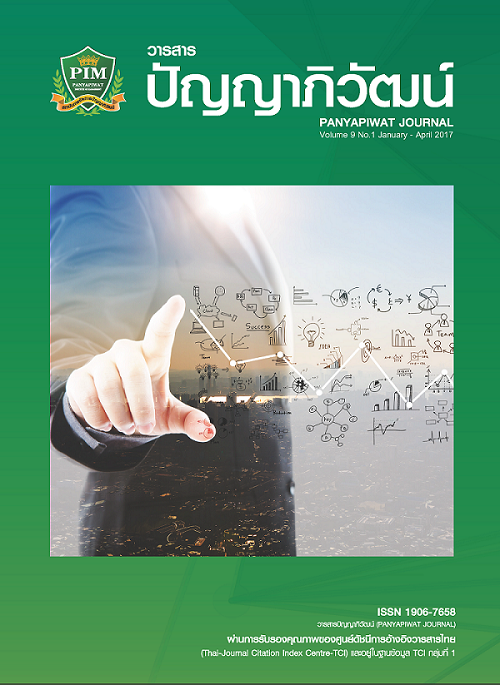การพัฒนาศูนย์นันทนาการสำหรับผู้สูงอายุด้วยวิธีการเทียบรอยคุณภาพ
Main Article Content
บทคัดย่อ
งานวิจัยส่วนนี้มีวัตถุประสงค์มุ่งศึกษาศูนย์นันทนาการผู้สูงอายุที่เป็นเลิศ (best practice) เพื่อค้นหาเคล็ดลับ (enabler) และนำมาเป็นต้นแบบสำหรับการดำเนินการจัดการศูนย์นันทนาการ บนพื้นฐานการวิจัยเชิงคุณภาพด้วยวิธีการเทียบรอยคุณภาพ โดยใช้การสัมภาษณ์เชิงลึก การสังเกต และการเยี่ยมชมเป็นเครื่องมือ มีการศึกษาและเก็บรวบรวมข้อมูลจากผู้ที่มีส่วนเกี่ยวข้องกับการบริหารจัดการศูนย์นันทนาการ ผลการวิจัยพบว่า เมื่อดำเนินการเทียบรอยคุณภาพสามารถค้นพบการปฏิบัติที่เป็นเลิศและเคล็ดลับของคู่เทียบรอยคุณภาพ คือชมรมผู้สูงอายุประดู่งาม อำเภอศรีเทพ จังหวัดเพชรบูรณ์ ดำเนินการในลักษณะโรงเรียนสร้างสุขผู้สูงอายุประดู่งาม มีศักยภาพด้านการดำเนินงานประสบความสำเร็จเป็นที่ยอมรับ ได้รับรางวัลยืนยันการดำเนินงาน สมาชิกชมรมมีศักยภาพ มีความภาคภูมิใจในตน กิจกรรมนันทนาการของชมรมมีเป้าหมายชัดเจน กำหนดปฏิทินการดำเนินกิจกรรม จัดหาสถานที่ให้สอดคล้องกับกิจกรรม โดยคำนึงถึงความสะดวก อากาศถ่ายเท มีความปลอดภัยต่อผู้สูงอายุเป็นหลัก และเป็นจุดศูนย์รวมการดำเนินกิจกรรมต่างๆ
เคล็ดลับที่ได้จากการเทียบรอยคุณภาพ ชมรมผู้สูงอายุ รพ.สต. ชีน้ำร้าย 1 สามารถนำมาเรียนรู้เพื่อปรับปรุงกลยุทธ์การดำเนินงานคือ ขั้นตอนแรก องค์การบริหารส่วนตำบลประดู่งามให้การสนับสนุนการดำเนินงานให้ความสำคัญต่อผู้สูงอายุ ขั้นตอนที่สอง กิจกรรมนันทนาการ องค์การบริหารส่วนตำบลประดู่งามให้การสนับสนุนจัดหาสถานที่ให้สอดคล้องกับกิจกรรมที่ได้ออกแบบไว้ ขั้นตอนที่สาม การดำเนินกิจกรรมนันทนาการ องค์การบริหารส่วนตำบลประดู่งามได้จัดหาเจ้าหน้าที่เพื่อประสานงานและดำเนินกิจกรรมโดยเฉพาะเพื่อให้การดำเนินงานเป็นไปอย่างต่อเนื่อง ด้านการสร้างความภาคภูมิใจในตนของผู้สูงอายุนั้นเพื่อกระตุ้นให้ผู้สูงอายุเข้าร่วมกิจกรรมด้วยความเต็มใจ ขั้นตอนที่สี่ การทบทวนผลการดำเนินกิจกรรมนันทนาการ เจ้าหน้าที่ประสานงานได้จัดทำข้อมูลเพื่อทบทวนการดำเนินกิจกรรม และขั้นตอนสุดท้ายการปรับปรุงแก้ไขมีกระบวนการทำงานตามวงจรคุณภาพ (PDCA)
กลยุทธ์การดำเนินกิจกรรมนันทนาการสำหรับผู้สูงอายุของชมรมผู้สูงอายุ รพ.สต. ชีน้ำร้าย 1 ที่ได้จากการเทียบรอยคุณภาพ ที่สามารถดำเนินการได้ทันทีโดยที่คำนึงถึงบริบท ทรัพยากร ทุนเดิมของชมรมที่มีอยู่และสามารถดำเนินการได้โดยไม่ส่งผลกระทบใดๆ หรือยากลำบากต่อการพัฒนา ปรับปรุง สามารถดำเนินการได้ 2 ประเด็นคือ 1) การจัดการประชุมคณะกรรมการชมรมผู้สูงอายุเพื่อดำเนินการจัดกิจกรรมนันทนาการให้กับผู้สูงอายุสอดคล้องกับความต้องการและบริบทของผู้สูงอายุ และ 2) การจัดหาอาคาร สถานที่เพื่อเป็นศูนย์รวมสำหรับการดำเนินกิจกรรมนันทนาการร่วมกัน โดยอาคารได้รับการออกแบบสำหรับเป็นต้นแบบศูนย์นันทนาการผู้สูงอายุ ซึ่ง รพ.สต. ชีน้ำร้าย 1 สนับสนุนพื้นที่ตั้งอาคาร งบประมาณบางส่วน และการสมทบทุนจากกลุ่มผู้สูงอายุ
This research aims to study the aging recreation center is best practice to find enabler and used as a prototype for the management of the recreational center base on qualitative research methods through benchmarking. Using in-depth interview, observation and site visit are tools. The study and collected data from who have been involved in the management of the recreational center. The research result found that when benchmarking process cab found the best practice and enabler of benchmarking partner. The benchmarking partner is The Society District Elderly Prodoongarm, Srithep, Phetchabun province in model Pradoongarm elderly happiness school. The potential operating successfully established, awards, high potential member, the self esteem, activities are targeted, activities calendar, providing a matching place with the activities (comfortable, airy, safety) and are activities center.
The enabler, The Society Elderly of Chi Nam Rai 1 health promoting hospital can be learned to improve operational strategy are the first step is the Prodoongarm sub district administrative organization office are supporter for operate and focus on elders. The second step is prepared the place and facilities for the appropriate activities. The third step is procurement offer to coordinate and carry out activities specifically to operation in ongoing. The pride in the self esteem to encourage elderly to participate willingly. The forth step is a staff were prepared to review the activities. And the last step is improve work process with the PDCA cycle.
The recreation strategy for the society elderly of Chi Nam Rai 1 got through benchmarking that can be implemented immediately without regard to the context, resources and the capital of the society elderly are available. And can be implemented without and consequences or difficulties in the development can be carries in 2 issues are 1) The society elderly meeting committee to conduct activities for the elderly in accordance with the requirements and context and 2) Provide the building to a center for recreational activities together. The building was designed as a prototype for the recreation center for the elderly. Which the Chi Nam Rai 1 health promoting hospital support area building, some budget and contributions from the elderly.
Article Details
“ข้าพเจ้าและผู้เขียนร่วม (ถ้ามี) ขอรับรองว่า บทความที่เสนอมานี้ยังไม่เคยได้รับการตีพิมพ์และไม่ได้อยู่ระหว่างกระบวนการพิจารณาลงตีพิมพ์ในวารสารหรือแหล่งเผยแพร่อื่นใด ข้าพเจ้าและผู้เขียนร่วมยอมรับหลักเกณฑ์การพิจารณาต้นฉบับ ทั้งยินยอมให้กองบรรณาธิการมีสิทธิ์พิจารณาและตรวจแก้ต้นฉบับได้ตามที่เห็นสมควร พร้อมนี้ขอมอบลิขสิทธิ์บทความที่ได้รับการตีพิมพ์ให้แก่สถาบันการจัดการปัญญาภิวัฒน์หากมีการฟ้องร้องเรื่องการละเมิดลิขสิทธิ์เกี่ยวกับภาพ กราฟ ข้อความส่วนใดส่วนหนึ่งและ/หรือข้อคิดเห็นที่ปรากฏในบทความข้าพเจ้าและผู้เขียนร่วมยินยอมรับผิดชอบแต่เพียงฝ่ายเดียว”
เอกสารอ้างอิง
Bain Management. (2016). Management tools and trends 2015.Retrieved September 9, 2016, from http://www.bain.com/management_tools/Management_tools_and_trends_2015.pdf
Bhuntuvech, C. (2004). Quality Management. Bangkok: Suan Sunandha Rajabhat University. [in Thai]
Boonyakit, B. & Siripanich, K. (2002). Benchmarking: Shortcut to Business Excellence. Bangkok: Thailand Productivity Institute. [in Thai]
Bowerman, M., Francis, G., Ball, A. & Fry, J. (2002). The evolution of benchmarking in UK local authorities.Benchmarking, 9(5), 429-449.
Carpinetti, L. C. R. & de Melo, A. M. (2002). What to benchmarking? A systematic approach and cases. Benchmarking, 9(3), 244-255.
Certo, S. C. (2003). Modern Management (9th ed.). Upper Saddle River, NJ: Prentice Hall.
Chapple, L. (2005). Funding and marketing trends for nonprofit arts organization: Case study, the berkshire music school (Massachusetts). Unpublished doctoral dissertation, University of Cincinnati.
Chung, W. K. (2001). Benchmarking Singapore’s high – TQM maturity organizations.Benchmarking, 8(1), 8-34.
Claerhout, L. A. & Cookson P. (2000). An international benchmarking study of copyright operations in distance education universities. Retrieved April 5, 2005, from http://cade.icaap.org/vol15.2/clearhoutetal.html
Daft, R. L. (2003). Management (6th ed). Mason, OH: Thompson South Western.Department of Health, Ministry of Public Health. (n.d.). The Role of the Elderly to Society, Family and Community. Retrieved March 10, 2014, from http://www.anamai.moph.go.th/soongwai [in Thai]
Devalersakul, N., Siriwarakoon, W. & Roadyim, C. (2016). The Development of the Elderly as a Burden to Power: Case Study of Rangsit City Municipality. Veridian E-Journal, 9(1), 529-545. [in Thai]
Evans, J. R. & Lindsay, W. M. (2005). The management and control of quality (6th ed.). Singapore: Thomson south-western.
Foundation for Older Person’ Development. (2014). Aging Society. Retrieved March 10, 2015, from http://fopder.or.th [in Thai]
Garlick, S. & Pryor, G. (2004). Benchmarking the university: Learning about improvement. Canberra: Australian Government, Department of Education, Science and Training.
Gryna, F. M. (2001). Quality planning and analysis: from product development through use.(4th ed.). New York: McGraw-Hill.
Kanji, G. K. & Asher, M. (1996). 100 methods for total quality management. London: SAGE.
Karjaluoto, H., Kiinikoski, S., Karjalainen, A., Kuortti, K., Deans, K. & Gnoth, J. (2004). Creative benchmarking in marketing education: Comparing best practices among divergent universities.Journal for Advancement of Marketing Education, 5, 27-36.
Lattanand, K. (2005). The strategies for improving the educational management of the nursing colleges under the jurisdiction of the ministry of public health (MOPH) through the benchmarking process. Unpublished doctoral Dissertation, Mahidol Unversity.
Lee, T. J. (2001). Benchmarking academic key performance indicators for higher education.Unpublished doctoral Dissertation, University of Minnesota.
Longbottom, D. (2000). Benchmarking in the UK: An empirical study of practitioners and academics.Benchmarking, 7(2), 98-117.
Maleyeff, J. (2003). Benchmarking performance indices: Pitfalls and solutions. Benchmarking, 10(1), 9-28.
Paitoonphong, T. (2005). Benchmarking. Bangkok: Suan Sunandha Rajabhat University. [in Thai]
Prasertpan, C., Piaseu, N., Mario, S. J. & Kittipimpanon, K. (2014). Activities and Outputs of a Senior Club in an Urban Community. Rama Nurse Journal, 20(3), 388-400. [in Thai]
Rohlfer, S. (2004). Benchmarking concepts in the UK and Germany: A shared understanding among key players?. Benchmarking, 11(5), 521-539.
Tubtimcharoon, N. (2012). Benchmarking: Management tool of the Academic Institute should not be overlooked. Panyapiwat Journal, 4(1), 97-111. [in Thai]
Wan, J. W., Abdullah, E. & Nooreha, H. (2000). Benchmarking institutions of higher education. Total Quality Management & Business Excellence, 11(4), 796-799.
Welch, D. (2001). Benchmarking the performance of employment and training programs: A pilot Effort of the Annie E. Casey Foundation’s Jobs Initiative. Retrieved March 19, 2006, from https://eric.ed.gov/?id=ED465068


